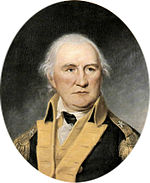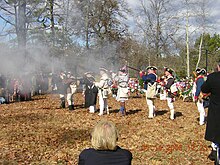Battle of Cowpens
American Patriot forces, estimated at 2,000 militia and regulars under Brigadier General Daniel Morgan, faced 1,000 British troops under Lieutenant Colonel Banastre Tarleton.
[7][8] Tactically, Cowpens demonstrated that American Patriot militia, when properly led, could inflict heavy casualties on Britain's best-trained troops.
Morgan evaded Cornwallis and joined General Nathanael Greene’s army near Greensboro, North Carolina, in early February, setting the stage for the Battle of Guilford Court House.
A victory of colonial militia over their Loyalist counterparts at the Battle of Kings Mountain on the northwest frontier in October had bought time, but the British still occupied most of South Carolina.
When Greene took command, the southern army numbered 2,307 men on paper (1,482 present), of whom 949 were Continental regulars, mostly of the famous and highly trained "Maryland Line" regiment.
He made the unconventional decision to divide his army, sending a detachment west of the Catawba River to raise the morale of the locals and find supplies beyond the limited amounts available around Charlotte.
Additionally, Cornwallis received incorrect intelligence claiming that Morgan was going to attack the important British fort of American Loyalists at Ninety Six, South Carolina.
In Tarleton's account published in the British Isles in 1781, he said that his horse had been shot from under him during the initial charge and his men, thinking him dead, engaged in "a vindictive asperity not easily restrained".
[27] On January 12 he received accurate news of Morgan's location and continued with hard marching, building boats to cross rivers that were flooding with winter rains.
The experienced British forces (and particularly their relatively young commander) were accustomed, especially in the Southern Theater, to easily routing often "green" militia, and could have underestimated the opposition.
[55] Morgan turned to his advantage the terrain of Cowpens, the varying reliability of his troops, his expectations of his opponent, and the time available before Tarleton's arrival.
[59][60] Selecting a low hill as the center of his position, he placed his Continental infantry on it,[61] deliberately leaving his flanks exposed to his opponent.
[61][63] Morgan asked the militia to fire two volleys, something they could do,[61] and then withdraw to the left and re-form in the rear behind the third line, under the cover of reserve light dragoons commanded by Washington and McCall.
[citation needed] Morgan, in arranging his battle lines at Cowpens, proposed "to turn a weakness into a strength" according to historian Alan Pell Crawford.
Anticipating the tendency for militia units to break ranks in the face of British bayonet charges, Morgan made a virtue out of a vice: "His plan is studied to this day.
[69] As soon as he reached the spot, Tarleton formed a battle line, which consisted of dragoons on his flanks, with his two grasshopper cannons in between the British Regulars and American Loyalists.
In reserve was the 250-man battalion of 71st Highlanders commanded by MacArthur, a professional soldier of long experience who had served in the Dutch Scotch Brigade.
Pickens's militia, having now reorganized, charged out from behind the hill, completing a 360-degree circle around the American position to hit the 71st Highlanders on the British left flank and rear.
Howard ordered the Virginia militia, whose withdrawal had brought on the British ill-fated charge, to turn about and attack the Scots from the other direction.
The shock of the sudden charge, coupled with the reappearance of the American militiamen on the left flank where Tarleton's exhausted men expected to see their own cavalry, proved too much for the British.
Babits diagnoses "combat shock" as the cause for this abrupt British collapse—the effects of exhaustion, hunger, and demoralization suddenly catching up with them.
Tarleton, realizing how desperate his situation was, rode back to his sole remaining intact unit, the British Legion cavalry.
[6] Although their charge was initially effective, the dragoons, numbering about 50, were quickly surprised and outnumbered by Washington's concealed cavalry, and they were driven back in disarray.
[6] Washington pursued Tarleton for 16 miles but gave up the chase when he came to the plantation of local planter Adam Goudylock near Thicketty Creek.
[6] Howard quoted McArthur of the 71st Highlanders, now a prisoner of the Americans, as saying "he was an officer before Tarleton was born; that the best troops in the service were put under 'that boy' to be sacrificed.
[87] Tarleton's apparent recklessness in pushing his command so hard in pursuit of Morgan may be explained by the fact that, up until Cowpens, every battle that he and his British Legion had fought in the South had been a relatively easy victory.
He appears to have been so concerned with pursuing Morgan that he quite forgot that it was necessary for his men to be in a fit condition to fight once they caught him, though Cornwallis did press Tarleton to take aggressive action.
[88][89] Coming in the wake of the American debacle at Camden, Cowpens was a surprising victory and a turning point that affected the psychology of the entire war—"spiriting up the people", not only those of the backcountry Carolinas, but those in all the Southern states.
Yet, after a long chase Cornwallis met Greene at the Battle of Guilford Court House, winning a victory but so weakening his army that he withdrew to Wilmington to rest and refit.
"[92] It gave Greene his chance to conduct a campaign of "dazzling shiftiness" that led Cornwallis by "an unbroken chain of consequences to the catastrophe at Yorktown which finally separated America from the British crown".










